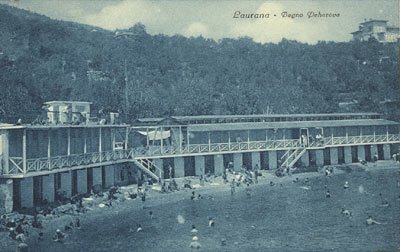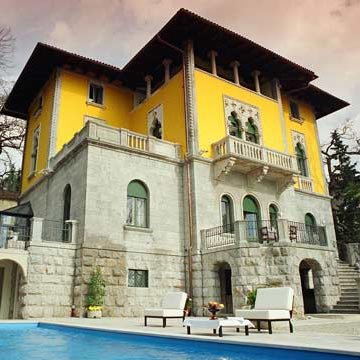



Tourism started to develop in Lovran about a hundred years ago (between 1891 and 1893), supported by the tourist development of the nearby Opatija, i.e. the construction of the 12-km long coastal promenade from Volosko over Opatija to Lovran, which was finished in 1884 and by the introduction of electric tram connection Matulji - Opatija - Lovran (1908). In 1905 the town became a climatic sanatorium. Numerous hotels and the landscaped environment made Lovran one of the popular jet-set winter resorts. Lovran was visited then by many famous figures (Tomás Garyg Masaryk, first president of Czechoslovakia). First it was popular as a winter resort, and after the Second World War it started to develop into a summer resort.



Lovran, a town of eternal natural attractions, near sea and mountain, of mild climate and valuable architectural heritage. Known in the Middle Ages as a town of seafarers, fishermen and traders, it was mentioned for the first time as far back as in the 7th century. In the period of transition between the 19th and the 20th century north and south of the old town nucleus secession villas were built, surrounded by carefully arranged parks and gardens. Some of these villas are part of the world architectural heritage and today are used in tourism as exclusive hotels-villas.
The natural park Učka Lovran chestnut-trees, and the developed mountain and mountain bike paths. You can taste the "marun" (chestnut) on occasion of the gastronomic manifestation Marunada, one of the numerous culinary manifestations where fruits of nature are prepared in the traditional way, following old Mediterranean cuisine recipes, in harmony with an ecologically protected environment.
Cherries Days, Asparagus Days are organized here, too.Accomodation in comfortable hotels, in secession villas or in the warm atmosphere of family houses, the rich gastronomic offer of the restaurants and of local "konobas"/ taverns, the walks along the coast on the seaside promenade, the numerous cultural events, are just a part of what Lovran offers with plenty of charm, hospitality and warmth...
The natural park Učka Lovran chestnut-trees, and the developed mountain and mountain bike paths. You can taste the "marun" (chestnut) on occasion of the gastronomic manifestation Marunada, one of the numerous culinary manifestations where fruits of nature are prepared in the traditional way, following old Mediterranean cuisine recipes, in harmony with an ecologically protected environment.
Cherries Days, Asparagus Days are organized here, too.Accomodation in comfortable hotels, in secession villas or in the warm atmosphere of family houses, the rich gastronomic offer of the restaurants and of local "konobas"/ taverns, the walks along the coast on the seaside promenade, the numerous cultural events, are just a part of what Lovran offers with plenty of charm, hospitality and warmth...

MORE THAN 100 YEARS TRADITION IN TOURISMUS!
In the Middle Ages, Lovran was known as a city of sailors, fishermen and merchants. A good climate, luxuriant Mediterranean vegetation and a favorable geographic location contributed to the rapid development of tourism during the late 19th and early 20th centuries. Since that time, Lovran, together with Opatija, has been the most important locality on the famed Riviera. Several villas dating from that period are part of the world architectural heritage. Lovran was named for the laurel trees (lovor) that grow there in abundance. In the hinterland are orchards where famous Lovran cherries and chestnuts cultivated. Luxurious villas former residences and summer homes of the Austro-Hungarian aristocracy, offer tourists accommodations of the highest category. From Lovran to Volosko is a 12 km coastal path, which provides guests with healtful exercise and unforgettable coastal panoramas. On the cliffs of Mt. Ucka are 11 mountain paths leading to Vojak (1396 m). The Mt. Ucka Nature Park stretches inland from Lovran. The Nature Park has an area of 146 km2, and the tallest peak is Vojak (1396 m). It is very rich in flora and fauna, and is particulary distinguished by a century-old forest of cultivated chestnuts, various species of medicinal plants and several endemic species of flowers. It also has mountaineering and mountain bike paths. There is a wide choice, and the visitor will discover unforgettable beauties in this upland area that is still within reach of the sea. Lovran has a rich architectural heritage. The medieval town center has remained well preserved, including the Church of St. George from the 12th century, the little Church of St. John the Baptist and the town tower. The Church of St. George is known for its baroque sanctuary, adorned with frescoes and Glagolitic inscriptions. Through the southern town gate known as Stubica, one arrives at a harbour with the little Church of the Holy Trinity. The rural architecture in the hinterland has the stylistic characteristics typical of Primorje-Istria. Fruits of the sea - fish,crab and shellfish - constitute the basic gastronomic offerings. Particularly outstanding are the famous Kvarner lagoustines (scampi). From an inland village, domestic specialities such as prosciutto, cheese, local wine and figs are delivered to restaurants and taverns. The best known gastronomic manifestation is the Marunada (Chestnut Festival) in the month of October. Cakes and desserts of cultivated chestnuts are prepared according to old family recipes. The Wild Asparagus Festival is held in the month of April, and Cherry Days are held in June!
The Story of Villa Astra

The Tree of Transformation
One crisp, mid-March morning, we strolled the Lungomare from Lovran, west towards Villa Astra and Icici, beneath handsome palms and trophy homes of its Habsburg past. Along this curious crescent of the eastern Adriatic, it was still too early for the wild asparagus but not for the sun’s energy. Our hearts rose with the scents of the sea and laurel in the air.
Lovran is named after lauriana, the laurel tree, symbol of transformation and eternity. It owes this meaning to the legend of Apollo and Daphne, children of the gods, who were parted by Cupid’s wicked arrow tips. Daphne, running from Apollo’s love, was transformed into a laurel, but Apollo swore his devotion and according to Ovid, wore the laurel thereafter. “As I am forever young, so you too shall never fade, your foliage ever green.”
A century ago, there came by Lovran an Italian noble named Nicolo Guerra –whose name means war – and here he discovered peace. As he wandered down from the spa town of Opatija in the lee of Mount Ucka, Guerra sensed the energy and decided to build this neo-Gothic marvel that is today Villa Astra. Like Venetian grandees and Viennese burghers before him, he looked out over the Kvarner Gulf, breathed deeply, and smelt the laurel.
Today, Nicolo Guerra has a natural successor in Vjeko Martinko, who has also travelled far, from career to calling. Here in Lovran he has restored fine buildings and hosted fine meals – of chestnuts and cherries, asparagus and scampi – and found his peace. Just as his guests have found the tree of transformation, forever green.
That evening, we sat waiting for the ferry back to the mainland below Lovran, watching the sun’s last rays fill the sea beyond Cres. We had arrived twenty four hours earlier, taut with stress. Already we were breathing freely, ready for love. Transformed.
Lovran is named after lauriana, the laurel tree, symbol of transformation and eternity. It owes this meaning to the legend of Apollo and Daphne, children of the gods, who were parted by Cupid’s wicked arrow tips. Daphne, running from Apollo’s love, was transformed into a laurel, but Apollo swore his devotion and according to Ovid, wore the laurel thereafter. “As I am forever young, so you too shall never fade, your foliage ever green.”
A century ago, there came by Lovran an Italian noble named Nicolo Guerra –whose name means war – and here he discovered peace. As he wandered down from the spa town of Opatija in the lee of Mount Ucka, Guerra sensed the energy and decided to build this neo-Gothic marvel that is today Villa Astra. Like Venetian grandees and Viennese burghers before him, he looked out over the Kvarner Gulf, breathed deeply, and smelt the laurel.
Today, Nicolo Guerra has a natural successor in Vjeko Martinko, who has also travelled far, from career to calling. Here in Lovran he has restored fine buildings and hosted fine meals – of chestnuts and cherries, asparagus and scampi – and found his peace. Just as his guests have found the tree of transformation, forever green.
That evening, we sat waiting for the ferry back to the mainland below Lovran, watching the sun’s last rays fill the sea beyond Cres. We had arrived twenty four hours earlier, taut with stress. Already we were breathing freely, ready for love. Transformed.

Thursday, July 5, 2007
Subscribe to:
Posts (Atom)






